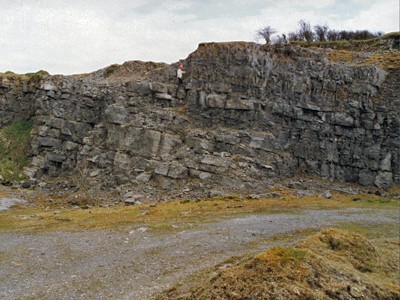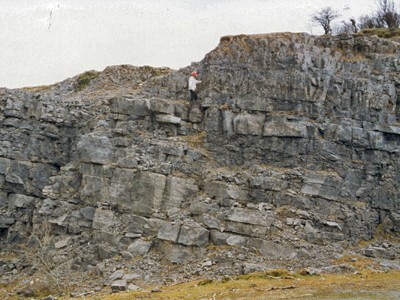Earth Science Conservation Review
| Crockanaver Quarry, Ederny | Fermanagh |

| Site Type: | Quarry (disused) |
| Site Status: | ASSI |
| Council area: | Fermanagh District Council |
| Grid Reference: | H223635 |
| Google maps: | 54.51985,-7.65562 |
| Rocks | |
|---|---|
| Rock Age: | Carboniferous (Arundian, Chadian, Visean) |
| Rock Name: | Ballyshannon Limestone Formation, Crockanaver Limestone Member, Tyrone Group |
| Rock Type: | Crinoidal limestone, Limestone |
| Interest | |
| Fossil Groups: | Brachiopod, Coral |
| Other interest: | Marine sediments |
Summary of site:
When rocks are named, they are defined by reference to a site where their main characteristics are best seen. Such sites become type localities, often called stratotypes and their names usually have a geographical component. This site is one such. The Crockenaver Quarry, 1.5km south of Ederny, contains the stratotype of the Crockenaver Limestone Member of the Ballyshannon Limestone Formation, formed in the early Carboniferous period.
A thickness of about 20m of limestones and shales is present in the quarry. The first 12m at the base of the face commence with granular limestones in beds of variable thicknesses with a little mud and become progressively muddier in beds thickening to 60cm towards the top. Corals and brachiopods are present, including the brachiopod species Delepinea carinata, indicating an age in the middle of the Arundian stage, about 344 million years ago. Above these beds are 2.5m of limestones containing blue-black chert. Almost exactly 1m above this bed is the base of the Crockenaver Limestone sitting on the dark grey limestone and shales. The member is about 10m thick and consists of fawn to pale grey, crinoidal limestones in beds ranging from thin to thick. With the exception of one brachiopod species, the fossils in the limestone are broken into fine fragments. It contains no shale.
The top of the member, forming the base of the overlying Ederny Limestone Member, is not seen in the quarry but is present in nearby ridges which fringe its southern margin.
The rock was formed in shallow water winnowed by marine currents that swept all mud away leaving the coarse, grainy limestone cemented with calcite. An inshore platform or bench is considered the most likely setting.
As the stratotype of the Crockenaver Limestone Member, this site is of national importance and should be designated for its scientific importance.
A thickness of about 20m of limestones and shales is present in the quarry. The first 12m at the base of the face commence with granular limestones in beds of variable thicknesses with a little mud and become progressively muddier in beds thickening to 60cm towards the top. Corals and brachiopods are present, including the brachiopod species Delepinea carinata, indicating an age in the middle of the Arundian stage, about 344 million years ago. Above these beds are 2.5m of limestones containing blue-black chert. Almost exactly 1m above this bed is the base of the Crockenaver Limestone sitting on the dark grey limestone and shales. The member is about 10m thick and consists of fawn to pale grey, crinoidal limestones in beds ranging from thin to thick. With the exception of one brachiopod species, the fossils in the limestone are broken into fine fragments. It contains no shale.
The top of the member, forming the base of the overlying Ederny Limestone Member, is not seen in the quarry but is present in nearby ridges which fringe its southern margin.
The rock was formed in shallow water winnowed by marine currents that swept all mud away leaving the coarse, grainy limestone cemented with calcite. An inshore platform or bench is considered the most likely setting.
As the stratotype of the Crockenaver Limestone Member, this site is of national importance and should be designated for its scientific importance.
| Enlander, I., Dempster, M. & Doughty, P., 2025. Crockanaver Quarry, Ederny, County Fermanagh, site summary. [In] Earth Science Conservation Review. https://www.habitas.org.uk/escr/summary.php?item=226. Accessed on 2025-04-03 |
| Previous Site | Next Site |

